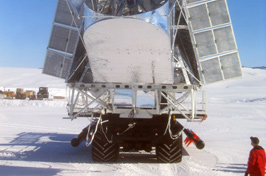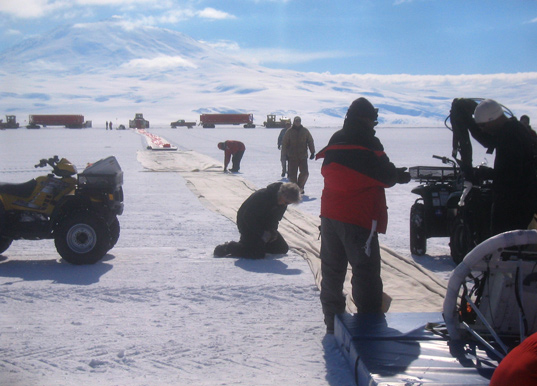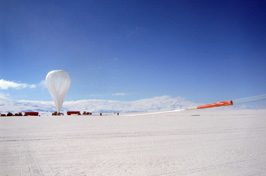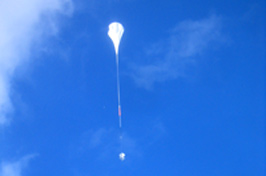|
|
| BLAST Mission 2006 – Antarctica |
|
|
Canada, the U.S., the U.K. and Mexico took part in a fascinating experiment at the end of December 2006 over Antarctica. Attached to a huge helium balloon, a 2,000-kg telescope called BLAST (Balloon-borne Large Aperture Sub-millimetre Telescope) stared deep into the sky to study distant stars and galaxies. Launched from the McMurdo Research Station in Antarctica, BLAST flew for 11 days, circling the frozen continent at an altitude of 38,000 metres. The two-metre telescope offers levels of sensitivity and resolution unmatched by any facility on Earth.
 The BLAST team is rolling the gondola outside a hangar at the McMurdo Science Station in Antarctica.
The BLAST team is rolling the gondola outside a hangar at the McMurdo Science Station in Antarctica.
(Photo: D. Wiebe, Physics Department,
University of Toronto) |
 BLAST is carried to the launch pad on a flat-bed truck. (Photo: D. Wiebe, Physics Department,
BLAST is carried to the launch pad on a flat-bed truck. (Photo: D. Wiebe, Physics Department,
University of Toronto) |
 The team lays the balloon on the ground before inflating it with helium gaz.
The team lays the balloon on the ground before inflating it with helium gaz.
(Photo: D. Wiebe, Physics Department, University of Toronto)
 The inflated balloon is ready to launch.
The inflated balloon is ready to launch.
(Photo: D. Wiebe, Physics Department,
University of Toronto) |
 BLAST is finally launched for a 10-day mission over Antarctica on December 21, 2006. (Photo: D. Wiebe, Physics Department, University of Toronto)
BLAST is finally launched for a 10-day mission over Antarctica on December 21, 2006. (Photo: D. Wiebe, Physics Department, University of Toronto) |
To learn more about the three completed BLAST flights, please follow this link: http://chile1.physics.upenn.edu/blastpublic/flights.shtml
|
